
* World War II saw the introduction of large rockets to combat. In the postwar, the US Army developed their first big battlefield rockets, the liquid-fuel "Corporal" and the "Redstone". They were not practical weapons, but they did lead to the solid-fuel "Sergeant", "Honest John", and "Lacrosse". The next generation beyond them included the solid-fuel "Pershing" and the smaller pre-packaged-fuel "Lance". Generally speaking, all these missiles were inaccurate and heavily dependent on the nuclear option.
* During World War II, the US Army made some use of solid-fuel barrage rockets, developed by the Army Ordnance Department. The initial "M8" rocket was used for both air and ground launch. It was 11.4 centimeters (4.5 inches) in diameter, 84 centimeters (33 inches) long, and weighed 17 kilograms (38 pounds) -- 2 kilograms (4.3 pounds) of that being warhead. Prototypes were built using fire-extinguisher casings. The M8 was propelled by nitrocellulose (smokeless powder) explosive. It was fired out of launch tubes and stabilized with pop-out fins. Triple launch tubes used on aircraft, while there were two primary types of launchers, carried on a truck or a tank:
There were other launchers, including 120-round and 140-round launchers for US Navy use. About 2.5 million M8 rockets were built during the war. The pop-out fins were not effective for a short time after launch, affecting accuracy, so in 1945 production went to the spin-stabilized "M16".
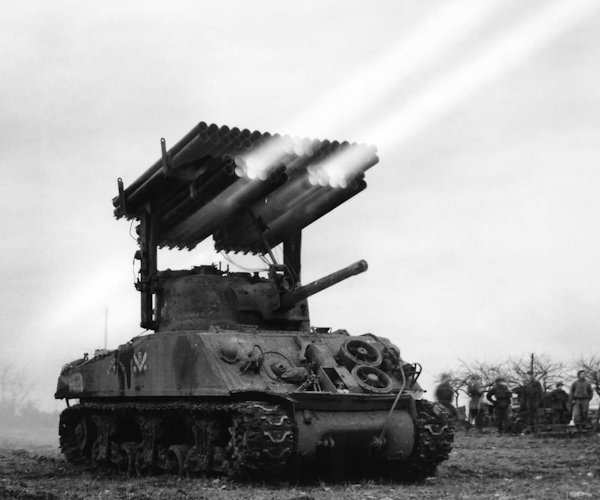
A number of other types of unguided rockets were developed as well, notably the "T37" short-range heavy demolition rocket, with a diameter of 18 centimeters (7.2 inches) and a mass of 28 kilograms (61 pounds), over half of that being warhead. Tracing down the details of US Army rockets of WW2 is difficult; enough to say the Army was never very enthusiastic about barrage rockets, much preferring conventional artillery, and abandoned the rockets after the war.
In the meantime, in 1943 a group of rocket enthusiasts at the California Institute of Technology (Caltech) that had been conducting experiments since 1936 had been established as the "Jet Propulsion Laboratory", under US Army sponsorship. During the war, they focused on "jet-assisted take-off (JATO)", later renamed "rocket-assisted take-off (RATO)" units for aircraft, assisted with development of unguided rockets, and tinkered with liquid-fuel rockets. They developed a series of experimental "Private" solid-fuel rockets, then went on to a series of "Corporal" liquid-fuel rockets, notably developing the "WAC Corporal" sounding rocket. It appears "WAC" stood for "Without Attitude Control", the rocket lacking guidance except for tailfins.
Along a parallel track, a German scientist named Wernher von Braun was working for Nazi Germany to develop a relatively long-range missile, the "V-2", which was used in a bombardment campaign against London and other targets from the fall of 1944 to the end of the war. At the end of the conflict, von Braun and his research team surrendered to the Americans, to become contract employees of the US Army, launching captured V-2s from White Sands, New Mexico.
Von Braun was technically well ahead of the JPL team, but they leveraged off his work to develop a series of improved sounding rockets. They also collaborated with von Braun under Project BUMPER, developing a multistage rocket using a V-2 as the first stage and a WAC-Corporal rocket as the second stage. There were eight BUMPER shots from 1948 to 1950.
* Meanwhile, JPL worked on a more ambitious Corporal rocket, the "Corporal E", with 11 of them built in successively refined configurations. The US Army felt that the Corporal E needed to be refined into an operational weapon, a "tactical ballistic missile (TBM)" named the "MGM-5 Corporal".
The first MGM-5 launch was in 1952, with the missile going into service in 1954. Firestone Tire and Rubber Company built the airframe, while the Gilfillan Brothers built the guidance system. It was powered by a liquid-fuel rocket motor, using pressure feed instead of turbopumps, generating 89 kN (9,070 kgp / 20,000 lbf) thrust. It burned storable propellants, at the outset consisting of aniline fuel and red fuming nitric acid (RFNA) oxidizer. The propellant mix was tweaked over the operational lifetime of the missile; the details are not very interesting, enough to say that storable propellants were nightmarish to handle. They were highly toxic and corrosive, and had the interesting property of being "hypergolic", meaning that fuel and oxidizer ignited spontaneously if mixed. That made rocket ignition easier, but also presented safety hazards.
___________________________________________________________________
MGM-5 CORPORAL:
___________________________________________________________________
length:
13.82 meters (45 feet 4 inches)
diameter:
76 centimeters (30 inches)
finspan:
2.1 meters (7 feet)
total weight:
1,670 kilograms (3,690 pounds)
warhead weight:
450 kilograms (1,000 pounds)
range:
48 to 130 kilometers (100 MI / 90 NMI)
___________________________________________________________________
The MGM-5 was armed with a W7 fission warhead, with a yield of about 20 kilotonnes. Sources mention that conventional warheads were developed, but the Corporal was too inaccurate for them to be very useful. The MGM-5 had an inertial navigation system (INS), but it was also tracked by radar, with course corrections transmitted to it. The missile was fitted with radar transponder beacons to help with tracking. Circular error probability (CEP) was about 350 meters (1,150 feet).

A Corporal battalion consisted of 250 men and 35 vehicles; setting up a missile took nine hours. After the launch, the battalion would pack up and leave the launch area as fast as possible to frustrate a counterstrike.
The original "Corporal I" variant was unacceptably unreliable and inaccurate -- the term "complete junk" was likely often applied -- and quickly was updated to the "Corporal II", which was generally improved in all respects. There was still much to be fixed, with development of "Corporal IIa" and "Corporal IIb" variants providing further improvement. Work was done on a "Corporal III" variant, but it never reached production. A total of 1,101 MGM-5s was built in all, 55 of them being developmental. It went into service with the British Army as well as the US Army. The Corporal was phased out of service in 1964.
BACK_TO_TOP* While JPL worked on Corporal, Wernher von Braun's group, having moved in 1950 to the Redstone Arsenal in Huntsville, built their own liquid-fuel TBM, the "Redstone", for the Army Ballistic Missile Agency (ABMA).
The Redstone was in effect an improved V-2, bigger but based on the same concepts. First flight of a prototype was in 1953, with introduction to operational service in 1958, being deployed to West Germany. Production missiles were built by Chrysler Corporation. The Redstone was originally designated as the "SSM-A-14" system, the missile component being the "M-8", the system later being redesignated to "PGM-11A".
___________________________________________________________________
PGM-11A REDSTONE:
___________________________________________________________________
length:
21.1 meters (69 feet 4 inches)
diameter:
1.8 meters (6 feet 11 inches)
finspan:
4 meters (13 feet)
total weight:
27,765 kilograms (61,205 pounds)
warhead weight:
3,100 kilograms (6,900 pounds)
max range:
48 to 130 kilometers (200 MI / 90 NMI)
___________________________________________________________________
The Redstone used a Rocketdyne A-7 rocket engine with 250 kN (35.4 kgp / 78,000 lbf) thrust. It burned ethyl alcohol fuel, mixed with water, along with liquid oxygen oxidizer. The Redstone had external control fins and also moveable vanes in the rocket exhaust. It used an INS, built by Ford, and carried a hefty W39 nuclear warhead, with a correspondingly hefty yield of 3.8 megatonnes. The warhead was carried in a separable, unpowered second stage with fins. Redstone had an INS with a CEP of 300 meters (1,000 feet).
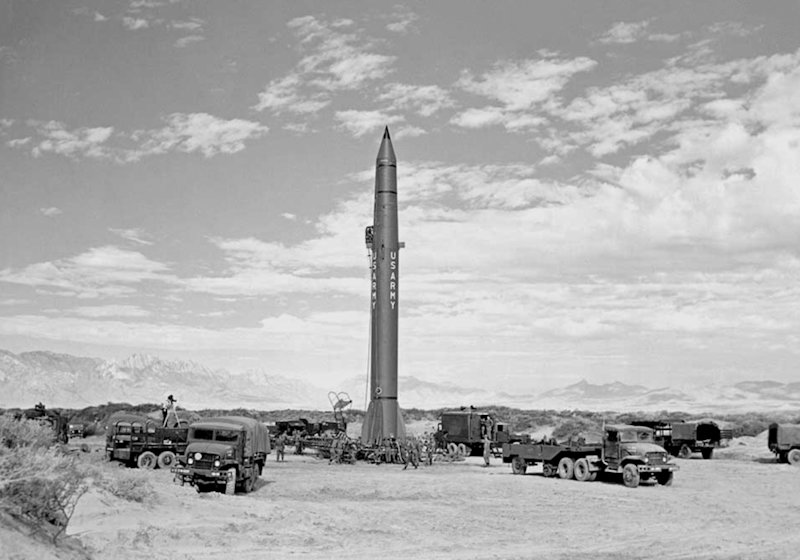
The initial "Block I" Redstone was followed by a "Block II". A total of 128 Redstones were built to 1961, with 27 produced by ABMA and 101 by Chrysler, 85 of the total being production weapons. It was finally retired from military service in 1964, with some put on display, the others scrapped.
* Redstone's military service was lackluster, but it played a significant role in the early years of the Space Race, with several variants used for test and space flight operations.
The first of the derivatives was the "Jupiter-C", stretched by 2.4 meters (8 feet), with elongated propellant tanks, and ethanol fuel replaced by "hydyne" -- which was 60% UDMH (unsymmetrical dimethylhydrazine) and 40% DETA (diethylenetriamine). Hydyne provided about 12% more thrust than ethanol, but was nastier to handle. The Jupiter-C had two nested upper stages, consisting of 14 Thiokol "Baby Sergeant" small solid-fuel rockets in a cylindrical "tub", with the tub set to spinning after launch for stabilization. The second stage was a ring of 11 Baby Sergeants in the tub, enclosing the third stage, a cluster of three Baby Sergeants. There were three Jupiter-C launches, all to test re-entry vehicles for the bigger "Jupiter" intermediate-range ballistic missile (IRBM).
At that time, the US was being dragged into a competition to put an Earth-orbiting satellite into space. The US Navy had been assigned the job, developing a booster named "Vanguard" to put a small satellite into orbit -- but the effort was underfunded and poorly managed, the result being that the first Vanguard launch attempt, on 2 October 1957, was an explosive failure. The USSR launched the first successful Earth-orbiting satellite, "Sputnik 1", on 4 October, and then launched a much bigger satellite, "Sputnik 2", a month later.
Von Braun and ABMA leadership had anticipated the failure of Vanguard, with a set of Jupiter-Cs having been stockpiled for use as a satellite launch vehicle, which became known as "Juno 1". It was little more than the Jupiter-C with a fourth stage on top of the tub, this final stage being a Baby Sergeant solid rocket with a small payload section on top. A Juno 1 was launched on 1 February 1958 and put America's first satellite, "Explorer 1", into orbit. There were five more Juno 1 shots in 1958, three of which were failures. It was followed by the "Juno 2", which was a Jupiter IRBM with the Juno 1 upper-stage assembly on top.
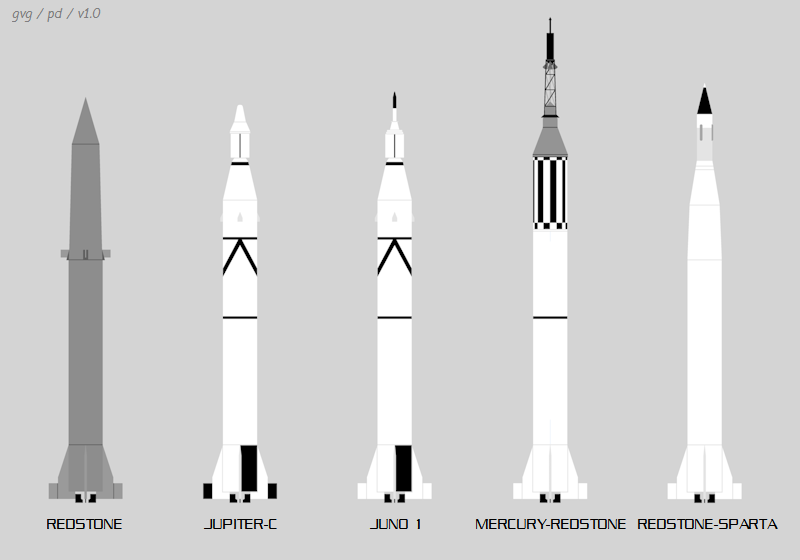
Late in 1958, the US National Aeronautics & Space Administration (NASA) was established to coordinate America's space efforts and put them under civilian control. One of NASA's first efforts was to put an astronaut into orbit around the Earth, with a "Mercury" one-person space capsule being designed, to be flown into orbit atop an Atlas intercontinental ballistic missile (ICBM). For Mercury tests, NASA turned to the Redstone, developing the "Mercury-Redstone" launcher to perform sub-orbital launches.
The Mercury-Redstone was more or less an "astronaut-rated" version of the Jupiter-C, with the bigger tanks, plus space for additional gear to support the Mercury capsule -- including telemetry systems and notably a launch escape system, in which a rocket-equipped "escape tower" would be activated to pull the Mercury capsule to safety in case of a booster failure. Hydyne was too troublesome for astronaut-rated flight, so it went back to ethanol for fuel. It also had a new, more reliable version of the A-7 rocket engine. The fuel burn time was longer than before, so the carbon vanes in the rocket exhaust were improved. There were five Mercury-Redstone launches:
Two more MR flights were planned, but canceled. Lastly, a set of military Redstones were converted to test out re-entry vehicles, being fitted with two solid-fuel upper stages. They were give the name of "Sparta" or "Redstone-Sparta", with ten launched from the Woomera Test Range in Australia in 1966:1967. The last of the ten put Australia's first satellite, "WRESat", into orbit.
* Corporal was retired because it had been rendered obsolete by the far superior JPL "MGM-29 Sergeant" TBM. The Sergeant effort had been initiated in the late 1940s, but it went through various twists and turns, going down dead ends, until the effort got on track in 1955. Even then, development did not go smoothly, with the Sergeant only going into service in 1962.
___________________________________________________________________
MGM-29 SERGEANT:
___________________________________________________________________
length:
10.52 meters (34 feet 6 inches)
diameter:
79 centimeters (31 inches)
finspan:
1.8 meters (5 feet 11 inches)
total weight:
4,600 kilograms (10,100 pounds)
warhead weight:
450 kilograms (1,000 pounds)
range:
140 kilometers (85 MI / 75 NMI)
___________________________________________________________________
The solid-rocket "grain" for the Sergeant was built by Thiokol at US Army Redstone Arsenal in Huntsville, Alabama. Specifics of the grain are not easy to find, but in general modern solid-rocket grains are primarily made up of a polymer fuel / binder, typically polybutadiene, which is basically synthetic tire rubber; plus ammonium perchlorate oxidizer and powered-aluminum booster mixed in the binder. The grains are usually cast around a "mandrel" that's removed after casting, leaving a void in the center with a star-shaped cross-section. The star shape gives a lot of burning surface after initial ignition, maximizing thrust, which falls off as the burn makes the void more cylindrical. In any case, the Sergeant grain led to the "Baby Sergeant" rockets used on the Jupiter-C and Juno 1 -- as well as the "Castor" grain, which was used as the second stage of the "Scout" light satellite launcher, and which led to a series of improved Castor grains.
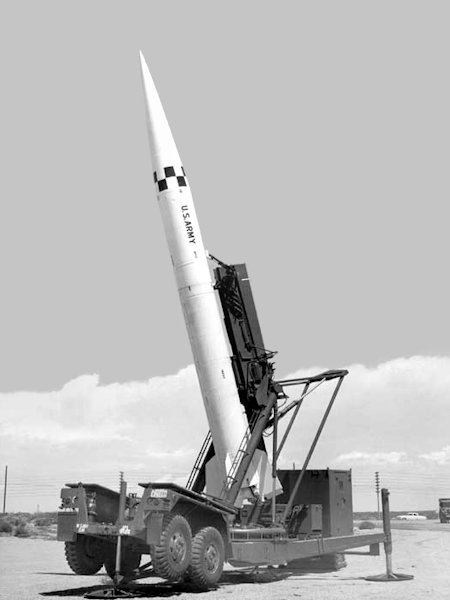
Sergeant carried a W52 (M65) nuclear warhead, with a yield of 200 kilotonnes. It had an INS with a CEP of 300 meters (1,000 feet). Alternative warheads, including high explosive, fragmentation, biological, and chemical warheads, were considered, but it seems never fielded. Roughly 500 Sergeants were built, being deployed with nine US Army battalions and four West German Army battalions. Sergeant was a big improvement on Corporal, but still left something to be desired, still requiring a lot of support equipment and fussing to launch. Nonetheless, for lack of anything better, it remained in service to 1979.
BACK_TO_TOP* Redstone Arsenal also developed a nuclear-capable solid-fuel tactical ballistic missile, the "MGR-1 Honest John". It was an unguided weapon, intended to be used for tactical nuclear strike. It was initially tested on 29 June 1951, with the first production rounds delivered in early 1953. Its designation was changed to "M31" in 1953. The first Army units received their rockets by year's end, and Honest John battalions were deployed in Europe in early 1954.
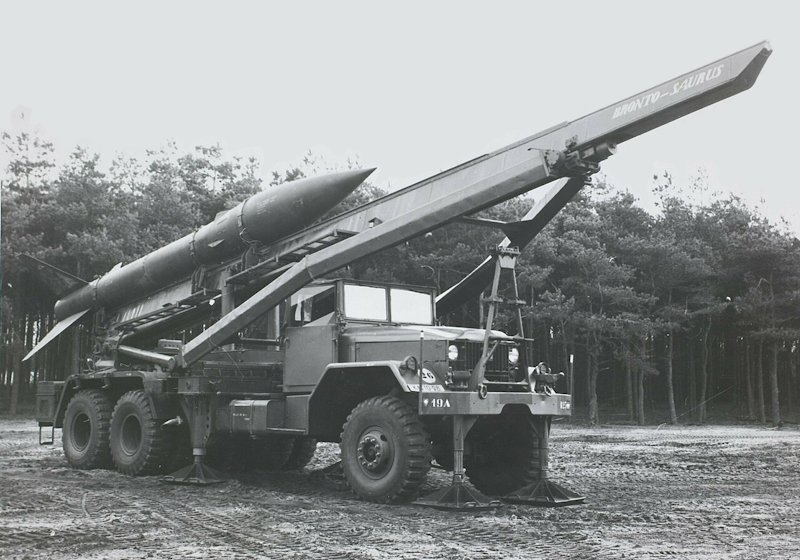
The Honest John was a simple rocket with four tailfins, capped by a bulbous warhead, in the form of a "W7" munition with a W7 Nuclear Warhead: The rocket was originally outfitted with a W7 nuclear warhead, with a variable yield of up to 20 kilotonnes. It was transported in three sections, to be assembled and placed on a rail launcher on a 6x6 truck. It had four small spin rockets to set it rotating for stability after launch.
___________________________________________________________________
MGR-1A / M31 HONEST JOHN:
___________________________________________________________________
length:
8.3 meters (27 feet 3 inches)
diameter (rocket body):
58 centimeters (23 inches)
diameter (warhead):
76 centimeters (30 inches)
finspan:
2.77 meters (9 feet 1 inch)
total weight:
2,640 kilograms (5,820 pounds)
warhead weight:
450 kilograms (1,000 pounds)
max range:
25 kilometers (15 MI / 13 NMI)
___________________________________________________________________
The MGR-1A / M31 was followed by the "MGR-1B / M50", which looked much the same except for length cut back to 7.92 meters (26 feet) and shorter tailfins with a span of 1.37 meters (4 feet 6 inches). The bigger tailfins of the M31 had made it more sensitive to crosswinds and affected accuracy; the M50 also was spun up to a higher rate to further improve accuracy.
The M50 had a more powerful rocket motor, thanks to more energetic rocket fuel, and weighed about 25% less, giving it an extended range of 48 kilometers (30 MI / 26 NMI). It had an W31 nuclear warhead that could have a yield of 2, 10, or 30 kilotonnes; it appears to have been much lighter than the older W7 warhead, accounting for the rocket's lower weight.
The Honest John could also be fitted with a high-explosive warhead weighing 680 kilograms (1,500 pounds). In addition, a cluster warhead consisting of nerve agent bomblets was developed -- originally an E19M79 / E19R1 cluster warhead, with 356 E130R1 / M134 bomblets, later replaced by the E19R2 / M190 cluster warhead, containing 356 E130R1 / M139 bomblets.
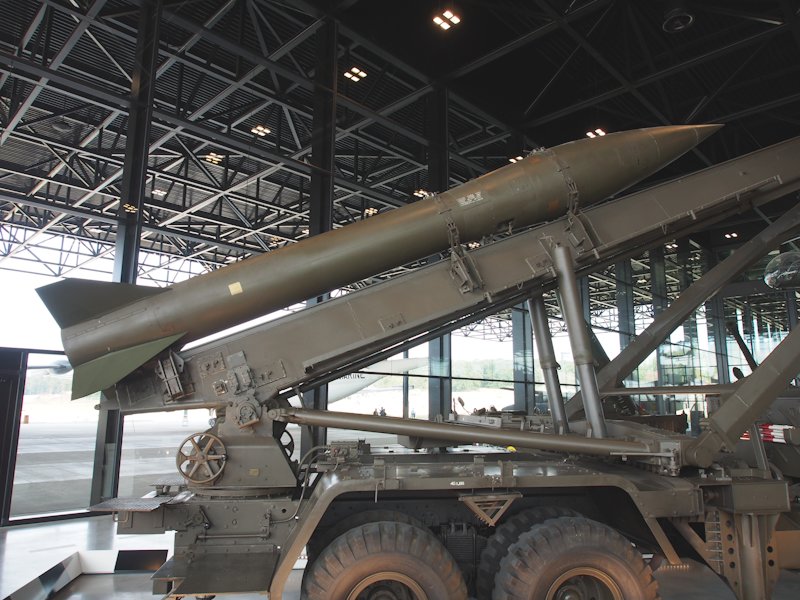
The Honest John was primarily a nuclear delivery system. The HE warhead would have been of limited use except at short ranges or if launched in barrages. The nerve-agent warheads were apparently stockpiled, but operational units never saw them; the US Army had little liking for chemical warfare.
Along with the US Army, the Honest John was operated by Belgium, Canada, Denmark, France, Germany, Greece, Italy, Netherlands, Norway, South Korea, Taiwan, Turkey, and the UK. Denmark, Norway, and Taiwan only operated the Honest John with conventional warheads; the rest were nuclear-capable, under a "dual-key" arrangement with the USA where the Americans had control over the warheads.
The last Honest Johns were manufactured in 1965, with total production of over 7,000 rockets. It was replaced in US Army service from 1973 by the Lance TBM, discussed below, though it lingered in Army National Guard for another decade, with some conventional Honest Johns in Greek, Turkish, and South Korean service persisting to the late 1990s.
* A smaller solid-fuel tactical ballistic missile, the "Lacrosse", was introduced roughly in parallel with the Honest John. It was originally a program for the US Marines, implemented by the Naval Research Lab (NRL), Johns Hopkins Applied Physics Laboratory (APL), and Cornell Aeronautical Laboratory, and designated "SSM-N-9". The program suffered from technical problems, schedule stretchouts, administrative zigzags, and funding shortages, being finally passed on to the US Army as the "SSM-G-12".
First all-up launches were in 1954, with the Martin company awarded a development and production contract in 1955, and production prototypes following. Problems continued, however, and the introduction of the "M-4" -- later "MGM-18" -- wasn't until 1959.
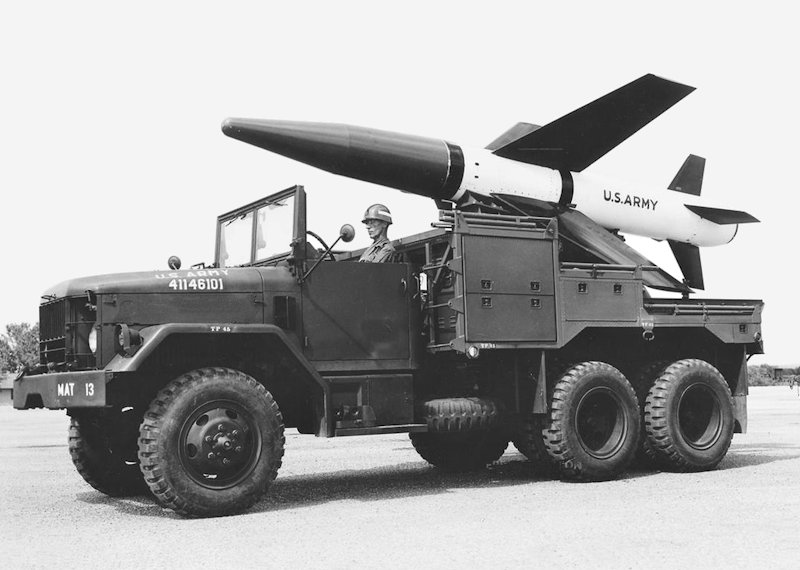
Lacrosse was a solid-fuel missile, with cruciform wings and launched from a 6x6 truck -- with a set of support vehicles attending. It could be fitted with a conventional warhead weighing 240 kilograms (540 pounds) or a W40 nuclear warhead, with a yield from 1.5 to 10 kilotonnes.
___________________________________________________________________
MGM-18 LACROSSE:
___________________________________________________________________
length:
5.95 meters (19 feet 2 inches)
diameter:
52 centimeters (20.5 inches)
wingspan:
2.7 meters (9 feet)
total weight:
1,000 kilograms (2,300 pounds)
max range:
19 kilometers (12 MI / 10 NMI)
___________________________________________________________________
Lacrosse was intended to be used as a short-range precision-guided weapon, with guidance provided by radio control from a forward observer post; work was also done on using an aircraft as a direction platform, though that didn't work out. Getting the system to work was troublesome, though in maturity Lacrosse had a CEP of a meter or two -- assuming the absence of adversary jamming, which was not a good assumption.
The last Lacrosse missiles were produced in 1964, with roughly 1200 built, and several battalions equipped with the missile. The Lacrosse was well-known to the public, with model kits readily available, but it is not clear that the MGM-18 was ever fully accepted into operational service. It was a pioneering attempt to build a precision-guided munition (PGM), and the idea was clearly ahead of its time.
BACK_TO_TOP* Just as Corporal was replaced by the solid-fuel Sergeant, the Redstone was replaced by the much more formidable solid-fuel "Pershing".
* In 1956, the US Army began studies for an "intermediate-range ballistic missile (IRBM)" that would have a range of 930 to 1,390 kilometers (580 to 865 miles / 500 to 750 NMI). The study was shelved when the Army was told that they couldn't operate missiles with a range of more than 320 kilometers (200 miles / 175 NMI), but that was restriction was lifted in 1958, with ABMA beginning work on the "Redstone-S", the "S" meaning "solid fuel". The Martin company -- later Martin Marietta -- got the development contract. The first launch of an "XM-14" test missile was in early 1960, with introduction to service of the "MGM-31" in 1963.
___________________________________________________________________
MGM-31 PERSHING I:
___________________________________________________________________
length:
10.5 meters (34 feet 7 inches)
diameter:
101 centimeters (3 feet 4 inches)
finspan:
1.75 meters (5 feet 9 inches)
total weight:
4,660 kilograms (10,275 pounds)
max range:
740 kilometers (460 MI / 400 NMI)
max speed:
Mach 8
___________________________________________________________________
The Pershing I was a two-stage solid-fuel missile, carrying a W50 nuclear warhead with a yield of 60, 200, or 400 kilotonnes. A conventional warhead was developed, but not deployed. It had an analog electro-mechanical INS with a CEP of 400 meters (1,300 feet), with control via fins and exhaust vanes. It used thrust reversal through vents for range control. The Pershing I was carried on an M474 tracked "transporter / erector / launcher (TEL)", accompanied by three support vehicles -- one carrying the warhead and other missile kit not carried on the TEL, a second providing power and test capabilities, a third providing troposcatter radio communications.
754 Pershing I missiles were built. The Pershing I was fielded with one US Army battalion at Fort Sill, Oklahoma, and two battalions in West Germany. Two wings were also operated by the West German air force, the Luftwaffe. It seems the number of launchers in each battalion / wing was, at least eventually, eight.
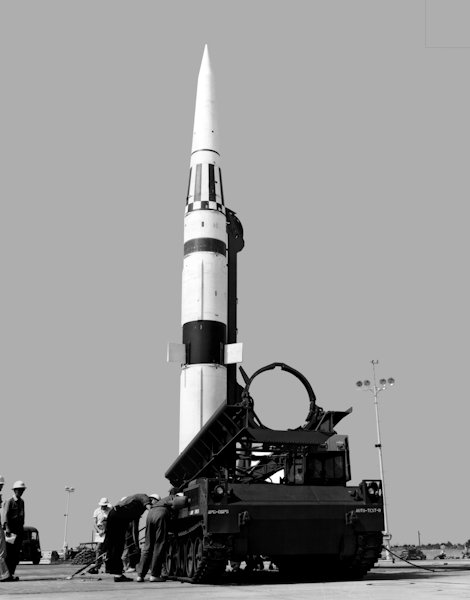
The Pershing I was followed by the "Pershing IA / MGM-31A" system, first deployed in 1969. There were no new-build Pershing IA missiles. The Pershing IA upgrade involved no modification to the missile itself, the most noticeable change being a switch from a tracked to an M790 wheeled TEL -- along with a general update of the support systems to make the system easier and faster to move, set up, and launch, as part of a program to support "Quick Reaction Alerts (QRA)". The number of launchers per battalion / wing was increased to 36. The ground support systems were given a series of updates, while the Pershing IA missiles were given an update in 1976 to make them faster and easier to launch.
* The Pershing I/IA was followed in turn by the "Pershing II". Development of the Pershing II began in 1973, with a development contract issued to Martin Marietta in 1975, test launches from 1977, and deployment with the US Army in 1983. The Germans retained the Pershing IA.
Configurationally, the Pershing II was like the Pershing I: a two-stage solid-fuel ballistic missile with a nuclear warhead. However, it was generally a new weapon, bigger and with range greatly extended, carrying a precision-guided re-entry vehicle, fitted with a radar-based terrain-matching seeker made by Goodyear. The warhead was also much lighter than the W50 of the Pershing I; the W50 was simply too big and powerful for the job. The Pershing II instead used the new W85 warhead, with a variable yield in the range of 5 to 80 kilotonnes; the lower yield demanded the use of the guided second stage to ensure adequate accuracy. An earth-penetrating W86 warhead was also considered, but not fielded.
___________________________________________________________________
MGM-31C PERSHING II:
___________________________________________________________________
length:
10.6 meters (34 feet 10 inches)
diameter:
101 centimeters (3 feet 4 inches)
finspan:
2.06 meters (6 feet 9 inches)
total weight:
7,460 kilograms (16,450 pounds)
max range:
1,770 kilometers (1,100 MI / 955 NMI)
max speed:
Mach 8
___________________________________________________________________
Although it had guidance fins for both stages, the exhaust fins for the first stage were replaced by a steerable nozzle. According to the Strategic Arms Limitation Talks (SALT) II agreement between the USA and USSR, new launchers could not be acquired for the Pershing II, with the old Pershing IA launchers considerably modernized -- it seems simply replaced -- instead. The launcher was a trailer unit, the "M1003", pulled by an M983 HEMTT tractor for US units, the M1001 MAN tractor for German forces. It seems that all functionality in the Pershing IA support vehicles was consolidated in the new launcher. Incidentally, SALT II was never actually ratified, but at the time both sides still abided by it.

276 Pershing IIs were built in all. The Pershing II was only deployed with the US Army, from 1983; the Germans retained the Pershing IA. All Pershings were retired in 1991, in accordance with the Intermediate-Range Nuclear Forces (INF) arms limitation agreement.
Several derivatives of the Pershing were proposed, one being a satellite launch vehicle named "Pegasus" that could put a 27-kilogram (60-pound) payload into low Earth orbit. Another proposal was the "Counter-Air(field) Missile (CAM)", which was an extended-range Pershing II with a cluster-munition warhead, intended to plaster airfields deep in an adversary's rear. CAM was part of the "Assault Breaker" program, an effort conducted from the late 1970s to develop improved surveillance and targeting systems, along with smarter guided munitions. CAM didn't happen, either, as was the case with many Assault Breaker programs -- but the effort paved the way to a new generation of weapons and tactical thinking.
BACK_TO_TOP* From the mid-1960s. the Army worked with Ling-Temco-Vought (LTV) to develop a replacement for the Honest John and Sergeant, the "MGM-52 Lance". It was introduced to service in 1972.
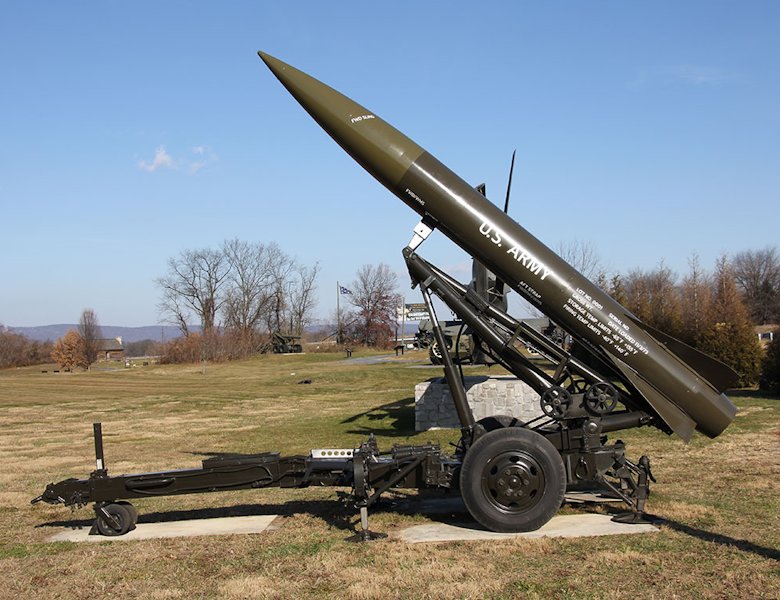
The Lance was of simple configuration, a spike of a rocket with cruciform tailfins. It was a liquid-fuel missile, using prepacked (sealed) storable propellants, including symmetrical dimethyl hydrazine fuel and fuming red nitric acid oxidizer. The rocket motor had an unconventional configuration, with a small sustainer engine mounted within a toroidal boost engine. Lance had an INS with a CEP of 150 meters (500 feet) and could be fitted with several different warheads:
Some sources mention that a unitary high-explosive warhead could be fitted as well, but the inaccuracy of the Lance made that a dubious proposition except for short-range attacks against hard targets.
___________________________________________________________________
MGM-52 LANCE:
___________________________________________________________________
length:
6.1 meters (20 feet)
body diameter:
56 centimeters (22 inches)
wingspan:
1.72 meters (5 feet 8 inches)
weight with conventional warhead
1,295 or 1,525 kilograms (2,850 or 3,367 pounds), depending on warhead
speed:
> Mach 3
maximum range (dependent on warhead)
120 kilometers (75 MI / 65 NMI)
___________________________________________________________________
Lance was carried on a tracked TEL, accompanied by reload vehicles. A Lance battery had two M752 launchers and two M688 tracked loader-transporters, with two missiles each. Rate of fire of a battery was about three missiles an hour. The launchers could also handle the MGR-1 Honest John, but it is unclear if this was ever done.

Lance was originally deployed in 1972, serving in South Korea and Europe. In 1990, the United States had 88 Lance launchers along with 300 HE warheads and 700 nuclear warheads for the Lance. Conventionally-armed Lances were obtained by Belgium, Germany, Iran, Israel, Italy, Netherlands, and the United Kingdom. The US retired the Lance in 1992 as part of the draw-down of tactical nuclear weapons, but the old Lances still put in good use as targets. Some conventionally-armed Lances may have lingered with foreign users.
BACK_TO_TOP